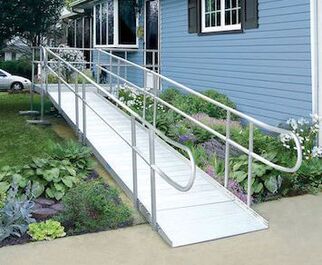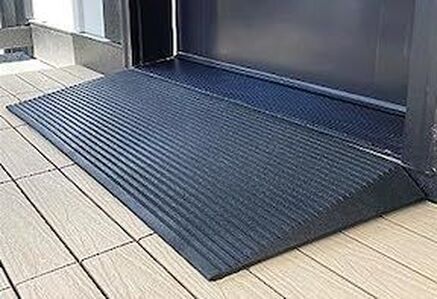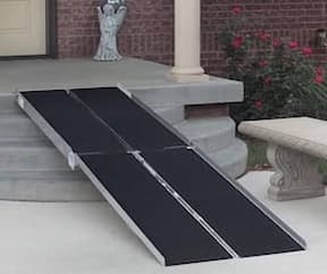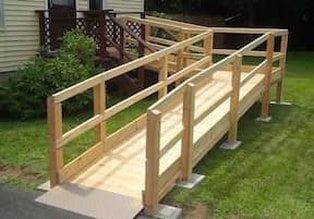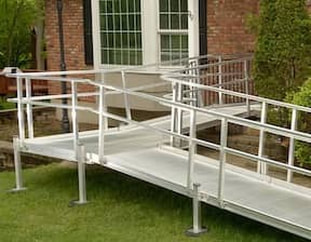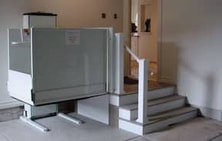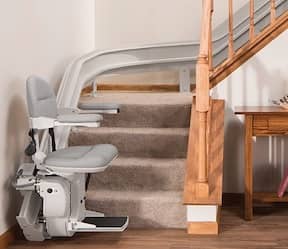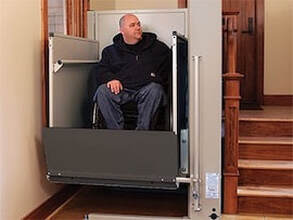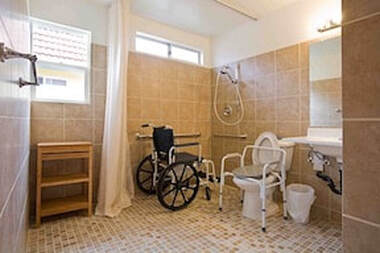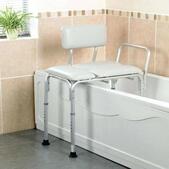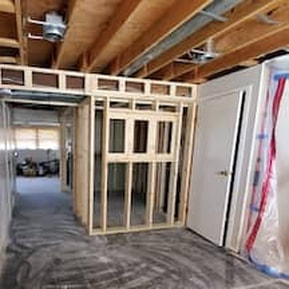Home Modifications for ALS |
|
|
As ALS progresses, entering, exiting, and maneuvering around your home can become challenging—and the thought of making renovations or even having to move can be overwhelming.
But if you talk with professionals, explore your options, and plan ahead, you may find that simpler solutions such as using adaptive equipment or making smaller changes can make your home more accessible. The ultimate goal is to be able to move safely around your home while remaining as independent as possible. |
|
Making Your Home More Accessible
|
Every home is different, so you will need to find professionals who can assess your living situation and make recommendations according to your current and future needs.
Ask your ALS clinic and/or local ALS organization if they can help schedule a home assessment visit by a physical therapist, occupational therapist, or other qualified professional. |
If an in-person visit is not possible, you can take photos and/or videos of your home to share with your ALS medical team, either virtually or when meeting in person.
For your home to be accessible, you need to make sure that you can get into and out of your home and safely maneuver inside it. Your immediate needs will depend on your current mobility status, but even if you are still walking, it is wise to plan ahead for the day you may need to use a custom power wheelchair.
Simple accessibility solutions include clearing your living space of clutter and removing potential trip hazards like rugs. You can also try rearranging furniture to make wider spaces for a walker or wheelchair.
Narrow doorways can prevent you from accessing certain parts of your home. If you have a power wheelchair, you will want doorways that are at least 32 inches wide. If your doorways are just a little too narrow, you can gain extra space by installing offset hinges, removing the trim, or even removing some interior doors altogether. If your doorways are still too narrow, you may need to hire a contractor to widen them.
For your home to be accessible, you need to make sure that you can get into and out of your home and safely maneuver inside it. Your immediate needs will depend on your current mobility status, but even if you are still walking, it is wise to plan ahead for the day you may need to use a custom power wheelchair.
Simple accessibility solutions include clearing your living space of clutter and removing potential trip hazards like rugs. You can also try rearranging furniture to make wider spaces for a walker or wheelchair.
Narrow doorways can prevent you from accessing certain parts of your home. If you have a power wheelchair, you will want doorways that are at least 32 inches wide. If your doorways are just a little too narrow, you can gain extra space by installing offset hinges, removing the trim, or even removing some interior doors altogether. If your doorways are still too narrow, you may need to hire a contractor to widen them.
Navigating Thresholds and Small Steps
|
Thresholds and small steps can be tripping hazards and obstacles for walkers and wheelchairs. Relatively inexpensive threshold ramps can help solve this problem. Threshold ramps can be fixed, adjustable, or modular and are often made of rubber, aluminum, or foam.
Threshold ramps are not covered by insurance. Ask your local ALS organization if they might be able to lend you one from their equipment loan closet. If you need to pay out of pocket, you can compare and purchase threshold ramps on websites like DiscountRamps.com and Amazon. If prefabricated ramps won’t work for your thresholds or steps, you may need to have a custom ramp built. You may be able to get assistance from local churches, charities, or organizations such as Habitat for Humanity, Elks, and Rotary. Boy Scouts may even be able to build you a custom ramp as a community service project. |
Ask an ALS professional for guidance before purchasing, installing, or building ramps for your home.
|
Sign up for our free newsletter to stay up-to-date on new content, equipment, ALS news, resources, and more.
|
Dealing with Multiple Steps
|
If you have multiple steps outside of your home, you may need a longer custom ramp to help you enter and exit. These wooden or aluminum ramps may be long and even turn, depending on your vertical rise and available space.
Ramps will vary in size and length depending on your needs. For safety reasons, ramps should have gradual slopes. The American Disability Act (ADA) requires public ramps to have 12 inches of length for every inch of vertical rise. Also keep in mind that a power wheelchair will need enough room to maneuver at the top and bottom of each ramp. Learn more about wheelchair ramp slope measurements. Ask an ALS professional or building contractor to visit your home and suggest the best type of ramp for you. |
To find a good contractor, you can ask your local ALS organization for recommendations, search online, or ask your chamber of commerce about companies that specialize in wheelchair ramps. If your family, friends, or community want to build you a ramp, here are some tips for measuring and building wheelchair ramps.
Custom ramps are not covered by insurance and often cost $5,000 or more. As with threshold ramps, ask about financial and material assistance options at your local ALS organization as well as churches, charities, and community organizations in your area.
Custom ramps are not covered by insurance and often cost $5,000 or more. As with threshold ramps, ask about financial and material assistance options at your local ALS organization as well as churches, charities, and community organizations in your area.
|
If you do not have enough room for a ramp, you may need a vertical platform lift. These motorized lifts are expensive and not covered by insurance, but may be your best solution in tight spaces like garages.
|
Accessing Your Multi-Level Home
|
If you are still walking but tire easily, you can try using a stairlift to help you go up and down your stairs. If you prefer to walk up and down, take your time, use handrails to prevent falls, and try to limit your trips to conserve energy. If you use a walker or standard wheelchair, you may be able to use either a stairlift or wheelchair stairlift. Keep in mind that you may need to have a second walker or wheelchair at the top or bottom of your stairs to move around on that floor.
Your options will be more limited if and when you are in a custom power wheelchair, which is too heavy for a wheelchair stair lift. Depending on the configuration of your home, you may be able to install a vertical platform lift that can raise and lower you and your power wheelchair. |
Stairlifts and vertical platform lifts can be expensive and are not covered by insurance unless you are a military veteran with service-connected benefits. Though rare, some families with enough resources and space have installed actual elevators in their homes.
If these options will not work for you, think about whether you could spend all or most of your time on one floor. This might involve repurposing a room or area to serve as your bedroom. Ideally you would also have an accessible bathroom on the floor. If you have the financial resources, you could renovate to create a fully accessible floor. Keep in mind that you will still need to be able to enter and exit your home safely and not feel isolated from others.
If none of these options are possible, you may need to talk with your family and ALS support team about the possibility of moving into a more accessible home or assisted living facility.
If these options will not work for you, think about whether you could spend all or most of your time on one floor. This might involve repurposing a room or area to serve as your bedroom. Ideally you would also have an accessible bathroom on the floor. If you have the financial resources, you could renovate to create a fully accessible floor. Keep in mind that you will still need to be able to enter and exit your home safely and not feel isolated from others.
If none of these options are possible, you may need to talk with your family and ALS support team about the possibility of moving into a more accessible home or assisted living facility.
Making Your Bathroom Accessible
|
The bathroom is often the most challenging room to access for people living with ALS. Some homes have narrower bathroom doorways, which can present problems for walkers, manual wheelchairs, and power wheelchairs. If you are not able to widen the doorway enough, you may need to transfer to a narrower rolling shower chair before entering your bathroom.
|
Your ability to shower and bathe will depend on your tub/shower setup. Wide roll-in showers offer the most accessibility and flexibility with shower chairs and Hoyer lifts. If you have a bathtub, you may be able to use a tub transfer bench or tub slider to help you bathe. Smaller showers with lips can be challenging and may be inaccessible.
If you are unable to bathe in your existing bathroom, you may need to renovate, use a portable shower outside of your bathroom, or take sponge baths.
Another challenge can be using the toilet. Toilet safety frames, raised toilet seats, and toilet seat bidets can help, though some bathrooms may be too small if you need transfer assistance. Options for toileting outside the bathroom include commode chairs, rolling shower commode chairs, portable male and female urinals, condom catheters, and diapers.
Safety and fall prevention in the bathroom are paramount. You can install grab bars near the toilet and shower as well as safety poles if needed.
If you are unable to bathe in your existing bathroom, you may need to renovate, use a portable shower outside of your bathroom, or take sponge baths.
Another challenge can be using the toilet. Toilet safety frames, raised toilet seats, and toilet seat bidets can help, though some bathrooms may be too small if you need transfer assistance. Options for toileting outside the bathroom include commode chairs, rolling shower commode chairs, portable male and female urinals, condom catheters, and diapers.
Safety and fall prevention in the bathroom are paramount. You can install grab bars near the toilet and shower as well as safety poles if needed.
Bathroom Equipment for ALSThere are many useful bathing and toileting devices that may help you use your bathroom more safely and independently without having to remodel. See devices.
|
Deciding to Renovate
|
If you are unable to make your home more accessible by using adaptive equipment and making smaller changes, you may want to consider remodeling the areas of your home that present the greatest challenges. Deciding to renovate is a personal decision that will depend on your finances, home layout, disease progression, care support, and other factors.
Home renovation projects can be disruptive to your daily lives and take longer than expected. They can also be expensive—and go over budget. Home accessibility renovations are not covered by insurance unless you are a military veteran with service-connected benefits. |
When deciding which changes to make, it may be helpful to reflect on your priorities. What is most important to you? Accessing your shower? Getting outside easily? Spending time with others?
The most common renovation projects for people living with ALS involve the bathroom. These include widening the doorway, creating a roll-in shower, installing a floating counter and sink for wheelchair accessibility, and adding more square footage if possible. Adding smooth, non-slip flooring can also improve safety and accessibility. Keep in mind that moving electrical and plumbing can result in significantly higher costs.
In addition to talking with professionals, try to get input from families affected by ALS who have already gone through this process.
The most common renovation projects for people living with ALS involve the bathroom. These include widening the doorway, creating a roll-in shower, installing a floating counter and sink for wheelchair accessibility, and adding more square footage if possible. Adding smooth, non-slip flooring can also improve safety and accessibility. Keep in mind that moving electrical and plumbing can result in significantly higher costs.
In addition to talking with professionals, try to get input from families affected by ALS who have already gone through this process.
ALS Home Renovation Video SeriesIf you are considering making home renovations, Matt's Place Foundation has developed a video series meant to serve as a guide for remodeling your home. Watch videos
|
Finding the Right Contractor
If you are going to do home renovations, you will want to find a trustworthy, licensed contractor with a good reputation who has either worked on accessible home modifications before or is at least familiar with ADA guidelines. Ask your local ALS organization, ALS clinic, family, friends, and wider community for recommendations.
You can also try contacting the Home Modification Occupational Therapy Alliance, the National Directory of Home Modification and Repair Resources, your local Area Agency on Aging, local contractor/building organizations, or your Better Business Bureau. You might also want to look for reviews on Google, Angi, or HomeAdvisor.
Reach out to multiple contractors, listen to their proposed solutions, and get quotes. You can either hire one general contractor to coordinate everything or hire individual specialists like carpenters, plumbers, and electricians.
Once you decide on a contractor, ask for a written agreement that specifies the exact tasks, timeline, and cost. Ask for a smaller down payment up front with at least half of the payment due upon satisfactory completion of the project. If you could use assistance, ask a trusted friend or family member to help review the agreement and monitor the work.
Your ALS Guide developed this page in collaboration with Matt Wild and Theresa Whitlock-Wild. Matt is a former U.S. Marine living with ALS who founded Matt's Place Foundation, which provides hope, housing, and assistance to families dealing with ALS. Theresa is an ALS caregiver who serves as Project Manager for the Adaptive Technology Center at the Steve Gleason Institute for Neuroscience.
You can also try contacting the Home Modification Occupational Therapy Alliance, the National Directory of Home Modification and Repair Resources, your local Area Agency on Aging, local contractor/building organizations, or your Better Business Bureau. You might also want to look for reviews on Google, Angi, or HomeAdvisor.
Reach out to multiple contractors, listen to their proposed solutions, and get quotes. You can either hire one general contractor to coordinate everything or hire individual specialists like carpenters, plumbers, and electricians.
Once you decide on a contractor, ask for a written agreement that specifies the exact tasks, timeline, and cost. Ask for a smaller down payment up front with at least half of the payment due upon satisfactory completion of the project. If you could use assistance, ask a trusted friend or family member to help review the agreement and monitor the work.
Your ALS Guide developed this page in collaboration with Matt Wild and Theresa Whitlock-Wild. Matt is a former U.S. Marine living with ALS who founded Matt's Place Foundation, which provides hope, housing, and assistance to families dealing with ALS. Theresa is an ALS caregiver who serves as Project Manager for the Adaptive Technology Center at the Steve Gleason Institute for Neuroscience.

